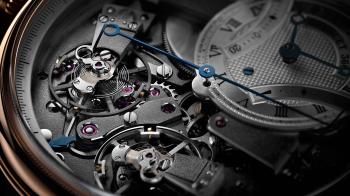Imagine yourself as Abraham-Louis Breguet in his workshop on Paris’ Quai de l’Horloge at the turn of the nineteenth century. In the relentless pursuit of timekeeping precision, you are drilling microscopic holes in each tooth of the escape wheel. Tooth by tooth. Why? To trap miniscule quantities of oil for lubrication at the point of contact between the escape wheel and the lever. Next to you on the bench is the balance wheel and its spring. You have done your best to form the spring and you have bestowed upon it your groundbreaking invention of the overcoil (which you cannot possibly know at the time, will two hundred years hence still bear your name, universally called by future watchmakers a “Breguet hairspring”). Although this timepiece will be sold as a “Garde Temps”, your highest grade movement, these solutions, the drilled escape wheel and the formed spring, are not perfect. Your technological tools, the best for your era, cannot carry you to the pinnacle of perfection.
Conjuring the future, Jules Verne in 1865 may have penned the tale of a journey to the moon a century before Neil Armstrong, yet not even the wildest flights of fancy in the Quai de l’Horloge atelier could have envisaged some of the solutions which technology has conferred upon today’s watchmakers in Breguet’s Vallée de Joux manufacture. A word of caution, or better said, an important perspective on technology’s role at Breguet: today’s material advances are never adopted simply because they are there or for flash and advertising talking points. For Breguet there must be both a tangible benefit to the performance of the timepiece delivering value to the owner and, in addition, compatibility with the traditional practices and skills of watchmaking hand craft. Guided by these principles, Breguet’s movement developers, working in tandem with research scientists, have brought cutting edge materials to today’s movements to achieve levels of precision and performance unimaginable in even the recent past. Bestowed upon today’s movements are components utilizing silicium, titanium, liquid metal®, diamond-like carbon and special alloys for the mainspring.
Breguet introduced its first timepieces incorporating silicium components in 2006 with the reference 5197. After five years of experience during which all of the performance expectations were met, Breguet’s CEO, Marc A. Hayek, true to the philosophy of his grandfather, Nicolas G. Hayek, reached the decision to incorporate silicium broadly throughout the collections. As of this writing, ten years after the initial introduction, there are less than a handful of legacy references which do not feature silicium springs and there are many references utilizing the material in areas in addition to the spring. It is a propitious moment to step back in order to summarize and highlight what has proven to be a revolutionary advance going to the very heart of a mechanical watch. In future issues of Le Quai de l’Horloge we will spotlight other modern materials and how they, too, have enriched the art of watchmaking.
![]()
The three key timekeeping elements of a watch are its balance wheel, including its spring, the escape wheel and the lever. It is in these fundamental components that the properties of silicium have opened up new frontiers.
Ever since Dutch mathematician Huygens developed the spring balance spring in 1675, this has been one element invariably common to all mechanical watches. Its contraction and expansion, which many describe as “breathing”, is central to the timing of the back and forth oscillations of the balance wheel and, thus, the running rate of the watch. In the more than three centuries following its invention, watchmakers have struggled to perfect the performance of the spring. Indeed, one of Abraham-Louis Breguet’s key inventions, the overcoil, was aimed at just that. By bending the outside portion of the spring upwards and over the remaining portion of the spring, Breguet was able to improve the centering of the spring around its axis and to make the spring “breathe” more evenly, that is to say, maintain a shape closer to the ideal of perfectly round, than was being achieved with the then existing spring shapes.
![]()
Springs in this era of watchmaking were formed by hand, which meant there were inevitable imperfections and, even with the improvements enabled by the Breguet overcoil, performance could not be idealized. Today, however, modern spring production machines have enabled great advances over the vintage hand formed springs. Shapes can be more perfectly formed. Thickness can be more precisely controlled. However impressive those innovations, the use of silicium for the spring leapfrogs even the finest predecessors in the pursuit of precision.
Springs fashioned in silicium can be produced with essentially perfect shapes, on the order of below one micron. But that is just the beginning of what silicium makes possible. Pre-existing methods for fabricating metallic springs progressively roll the alloy until it is in the form of a fine wire, flatten it into a thin rectangular profile, and, finally, wind it into a coiled shape. With this kind of process, introducing variations along the length of the springs is not feasible. Silicium springs, on the other hand, are fabricated from wafers where material can be removed as desired. Thus, it becomes possible to engineer precise variations in thickness or coil spacing into the fabrication process. Movement designers using computer simulations can determine the exact characteristics of thickness and shape along portions of the spring that will optimize its performance in the movement. An easily visible example is found in Breguet’s Chronométrie. Its balance wheel is fitted with two silicium springs that not only are thicker at their outer attachment points, they have been fabricated to be essentially rigid for a portion of their lengths, thereby moving the flexible location to a predetermined ideal location.
![]()
One of the important considerations in the design of a watch movement is how the running rate will be affected as the watch barrel unwinds over time. The torque delivered by the barrel is, of course, at its maximum when fully wound and drops as it unwinds, as for example after 24 hours, 48 hours or more, depending on the movement. This drop can change the running rate. The term “isochronism” is used by watchmakers to express this aspect of performance. Silicium helps to optimize isochronism performance in two ways. First, the shape can be idealized when it is fabricated to address isochronism. Second, and a bit of a simplification to state it this way, a spring made of silicium is less affected by the dropping of torque than pre-existing metallic alloys.
Lightness is another prized property of silicium. To understand how this improves the performance of the spring, a brief tutorial on one of watchmaking’s challenges. In an idealized world, a mechanical watch’s spring would be perfectly centered on its central axis and remain so as it breathes inward and outward. This would place its center of gravity upon the axis. Unfortunately, that idealized vision can’t be attained, so that the center of gravity of the spring will inevitably be displaced somewhat from the center since, after all, it must be attached to the balance staff. This causes what watchmakers term the “Grossmann effect”, which is used to describe errors which result from changes in vertical position. Because the center of gravity of the spring is displaced from the center, depending upon the position of the watch, the force of gravity creates a torque which, acting upon the spring, will have an effect on the frequency of the balance wheel’s swing; in some positions adding to it, in others subtracting. Naturally, this changes the running rate of the watch. Because silicium is lighter than pre-existing metallic springs, this Grossmann effect is diminished.
One of the enemies of traditional metallic springs is magnetism. When exposed to a sufficiently strong magnetic field, there is a risk that sections of metallic springs can become magnetized. When this happens, these miniature magnets in the coils can either attract or repel each other. This changes the characteristics of the spring which, in turn, changes the running rate of the timepiece. Indeed, responding to this risk, it became common throughout the industry to equip watches, principally in the diving arena, with a soft iron inner case to shield the spring from magnetism. The drawbacks of this approach were many as it made the watches both thicker and heavier and essentially prevented incorporation of a clear case back. As it is naturally amagnetic, silicium is not subject to this risk of being magnetized and renders unnecessary older shielding methods while at the same time protecting from magnetism to an equivalent degree. As well, for Breguet there is a further benefit from the amagnetic properties of silicium, as it has enabled beneficial uses of magnets within the heart of its movements without risk to the running rate. Two examples: the Chronométrie that features magnetic pivots for the balance wheel’s staff and the magnetic regulator for the Musicale. Both of these inventions have been patented.
![]()
Not to be overlooked are the effects of age on the characteristics of springs. Over time, with traditional spring ma- terials one may witness changes in stiffness which may negatively manifest itself in both the running rate and isochronism. In contrast, silicium remains stable and is not subject to metal fatigue as the watch ages.
The list of positive attributes is long and thermal compensation also merits a prominent place. It was discovered that silicium oxide coated onto the hairspring not only minimizes the effects of temperature changes to a degree, for example, well below the Swiss chronometer COSC standards, but as well allowed Breguet’s movement designers to tailor the compensation to match the particular characteristics of the material used for the movement’s balance wheel. This is important as, according to the movement, Breguet uses both Glucydur and titanium for its balance wheels which have different thermal properties.
All of these attributes represent major advances in watchmaking which has led Breguet to adopt silicium for the springs in nearly all of its movements. In certain movements, Breguet has used silicium for other components central to timekeeping. In the Type XXII, in addition to the spring, both the lever and the escape wheel are in silicium. The Type XXII was Breguet’s first timepiece built to run at a frequency of 10 Hz or 72,000 beats per hour. With the watchmaking norm falling between 2.5 and 4 Hz, the movement in the Type XXII broke new ground both for mechanical movements in general and chronographs in particular. Two properties of silicium recommended themselves for the lever and escape wheel: lightness and improved frictional properties (recall the painstaking drilling of holes two hundred years ago to battle friction). Lightness not only reduces the energy consumption of the movement, vital if one wants to achieve high frequencies, but, related, it also contributes to lower inertia of the components, important when they are oscillating so rapidly.
![]()
The Type XXII is not the only Breguet timepiece with silicium components beyond the balance spring. The Chronométrie has been outfitted with a silicium escape wheel whose lightened form allowed the movement to achieve its 10 Hz frequency. References 5177 and 5837 all have silicium escape wheels and levers.
It is not an overstatement to say that for movement designers, watchmakers, watch connoisseurs and, of course, every owner of a timepiece fitted with silicium components, silicium represents no less than a major advance in the art. The full range of its desirable physical properties justifies placing it amongst the ranks of the most important watchmaking innovations in history.




